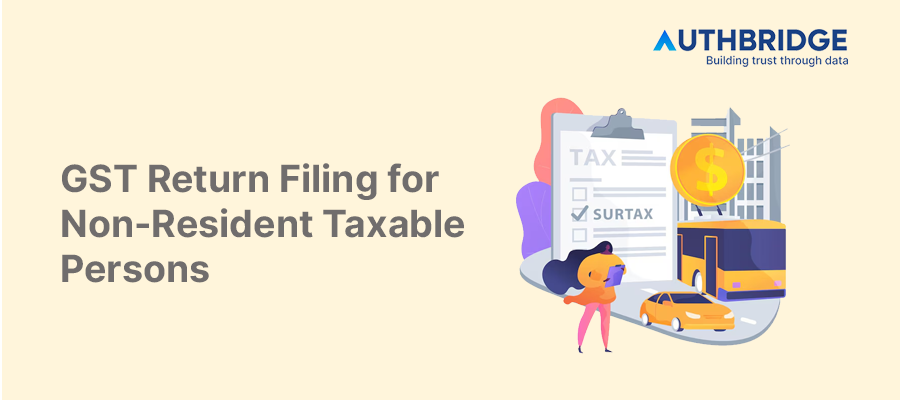Navigating GST Return Filing For Non-Resident Taxable Persons

1. Introduction to GST Registration for Non-Resident Taxable Persons
Overview
Non-Resident Taxable Persons engaging in business activities in India are required to register under GST to comply with Indian tax regulations. This registration enables them to undertake taxable supply of goods or services under the GST regime.
Importance of GST Registration
Registering under GST is crucial for non-resident entities as it legalizes their business operations in India. It ensures they can claim input tax credit, file GST returns, and comply with Indian tax laws, thereby avoiding penalties and legal issues.
2. Steps for Applying for GST Registration
Registering as a Non-Resident Taxable Person under GST involves a systematic process on the GST portal. Here's a detailed guide to navigate through the application process:
Accessing the GST Portal
- Start by visiting the official GST website:https://www.gst.gov.in/.
- Navigate to Services > Registration > New Registration to begin the process.
Filling the Application Form: Part A and Part B
The application form is divided into two parts, each requiring specific details:
- Part A:
- Select 'New Registration' and choose 'Non-resident Taxable Person' from the 'I am a' dropdown menu.
- Enter the State/UT and District where registration is required.
- Provide the Legal Name of the Non-resident Taxpayer as per the PAN or the passport for foreigners without a PAN.
- Select the identification type: Permanent Account Number (PAN), Passport Number, or Tax Identification Number (TIN) based on the entity's origin country.
- Part B:
- Fill in the Authorized Signatory details, including Name, PAN, Email Address, and Mobile Number. This step is crucial as all communications will be directed to these contacts.
- Complete the OTP verification using the OTP sent to the registered mobile number and email address.
- A Temporary Reference Number (TRN) will be generated, which you can use to resume the registration process if needed.
Submission of Required Documents
You'll need to upload various documents based on the nature of your business and the information provided:
Document Type | Format | Size Limit |
Photograph of Authorized Signatory | JPG | 100 KB |
Proof of Appointment of Authorized Signatory | PDF/JPG | 100 KB |
Proof of Principal Place of Business | PDF/JPG | 100 KB - 2 MB |
Bank Account Details | PDF/JPG | 100 KB |
Verification and Submission
- Verify the details entered in the application form for accuracy.
- Sign the application digitally using a Digital Signature Certificate (DSC) for companies or E-Signature/EVC for other entities.
- Apply and note the Application Reference Number (ARN) for tracking the application status.
Acknowledgement and ARN Generation
Once submitted, you will receive an acknowledgement within 15 minutes on your registered email and mobile number, along with the ARN. The ARN can be used to track the status of your GST registration application.
3. Required Documents for GST Registration
For a Non-Resident Taxable Person to successfully register under GST, certain documents are mandatory. These documents vary based on the nature of the business and the legal status of the entity. Below is a comprehensive list and the specifications for each document type.
Legal Documents
- Proof of Business Registration or Incorporation Certificate: Document evidencing the legal existence of the business in its home country.
- Authorization Form: For the authorized signatory chosen by the non-resident taxable person, indicating the person’s name and other details as recognized by the business.
Authorized Signatory Details
- Photograph: Passport-sized photograph of the authorized signatory.
- Proof of Appointment: Document such as a letter of authorization or a copy of the board resolution passed by the managing committee, evidencing the appointment of the authorized signatory.
Principal Place of Business
Proof of the principal place of business is required, which can be any of the following, depending on the nature of possession:
Nature of Possession | Document Required |
Own | Property Tax Receipt, Municipal Khata copy, Electricity bill, or Legal ownership document |
Leased | Rent/Lease agreement along with any one of the above-mentioned ownership documents |
Rented | Rent agreement and NOC from the owner, along with any one of the ownership documents |
Consent | Consent letter and any one of the ownership documents |
Shared | Consent letter and any one of the ownership documents |
Others | Legal ownership document |
Each document should be in PDF or JPEG format, with a maximum file size of 1 MB for all documents except the rent/lease agreement, which can be up to 2 MB.
Bank Account Details
Non-resident taxable persons are required to submit details of their bank account(s) in India, including:
- Bank Account Number
- Account Holder’s Name
- IFSC Code
- Proof of Bank Account: A copy of the first page of the passbook, bank statement, or cancelled cheque.
These documents must be in PDF or JPEG format, with a file size not exceeding 100 KB.
Document Upload and Verification
Upon gathering all required documents, the applicant must upload them to the GST portal during the registration process. It's crucial to ensure that all documents are clear and legible to avoid any delays or rejections of the application.
After uploading, the application will undergo a verification process. If everything is in order, the GST registration certificate will be issued. It's important to note that the registration process is not complete until all required documents are submitted and verified.
4. Verification and Submission
After completing the application form and attaching all necessary documents, the final step in the GST registration process for Non-Resident Taxable Persons involves verification and submission. This step is crucial as it ensures the authenticity and accuracy of the information provided.
OTP Verification
- Mobile and Email OTP: Upon filling out the application form, an OTP will be sent to the registered mobile number and email address for verification purposes. This OTP is valid for only 10 minutes, emphasizing the need for prompt action.
Digital Signature Certificate (DSC)/E-Signature or EVC
- Digital Signature: The application must be signed digitally. For companies, a Digital Signature Certificate (DSC) is mandatory. Other entities can opt for an E-Signature or Electronic Verification Code (EVC) based on Aadhaar authentication.
- DSC: Ensure the DSC dongle is connected to your computer and the required software is installed and running.
- E-Signature: Available for individuals with an Aadhaar number, linking the application to a verified identity.
- EVC: An OTP sent to the registered mobile number and email, used for verification.
Submission and Acknowledgement
- Submit the Application: After completing the verification, submit the application. A success message will be displayed, and an Application Reference Number (ARN) will be sent to the registered email and mobile number.
- ARN Generation: The ARN is crucial for tracking the status of your GST registration application. It signifies that the application has been successfully submitted and is under review.
5. Post-Registration Steps
Provisional GSTIN
- Upon submission, a provisional GSTIN is generated. This number is temporary and will be replaced by a permanent GSTIN once the application is approved and all verifications are completed.
Submission of Bank Account Details
- Initially, the submission of bank account details was mandatory at the time of registration. However, this requirement has been relaxed. Now, non-resident taxable persons can submit their bank account details post-registration, through an amendment application.
Status of the Application
- The status of your GST registration application can be tracked using the ARN on the GST portal. The possible statuses include:
- Draft: Application not yet submitted.
- Pending for Validation: Application submitted, awaiting validation of PAN and other details.
- Pending for Processing: Under review by the tax officer.
- Approved: Application approved, GSTIN issued.
- Rejected: Application not approved, with reasons provided for rejection.
Conclusion
The GST registration process for Non-Resident Taxable Persons is designed to ensure compliance with Indian tax laws while facilitating ease of doing business. By following the detailed steps for application, submission, and post-registration requirements, non-resident entities can ensure a smooth transition into the GST regime. It's important to keep all documents ready, follow the verification protocols, and track the application status until the final GSTIN is issued. This proactive approach will help in avoiding any compliance issues and ensure a seamless business operation in India.
Category

Abhinandan Banerjee
(Associate Manager - Marketing)
Abhinandan is a dynamic Product and Content Marketer, boasting over seven years of experience in crafting impactful marketing strategies across diverse environments. Known for his strategic insights, he propels digital growth and boosts brand visibility by transforming complex ideas into compelling content that inspires action.



